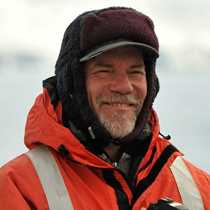At Sea
Over the past two centuries, the seas surrounding the Southern Continent have beckoned to explorers with the unknown, drawn whalers and sealers with promises of wealth and lured travelers with their mystery and beauty. Hidden at the bottom of the globe, these icy waters have always seemed a world apart, a place of promise and possibility.
James Cook sailed thousands of miles through the Southern Ocean in his quest for Terra Australis Incognita during his second voyage on the HMS Resolution. Only a few decades later the southern land was no longer unknown and the race for the resources of its seas was on. Huge harvests of fur and oil from seals and whales awaited those adventurous enough to make the dangerous journey and soon dozens of ships were making regular voyages too exploit these newfound riches.
New generations of explorers and scientists came as well, seeking the pole, opening new passages, slowly gaining knowledge of the strange world and unique wildlife of Antarctic waters. Dumont d’Urville, James Clark Ross, Jean Baptiste Charcot, many of the great explorers turned their attention to the sea and made early attempts to understand its mysteries.
Scientists still seek answers to many questions here, but now travelers who come for pleasure outnumber them many times over. The mountain scenery of the Antarctic is one great draw, but it is the seas that provide all the most popular sights and experiences. Penguins, seals, whales, icebergs, pack ice, virtually all the wildlife and many of the unusual scenes that lure us here are ultimately dependant on the nature of this remote, freezing ocean.
These frigid waters still hold much evidence of all this history and change. Bottles discarded from explorers’ ships, the bones of great whales and base supply vessels now become artificial reefs lie silently on the bottom, monuments to our changing, growing relationship with the seas of Antarctica.
Over the past two centuries, the seas surrounding the Southern Continent have beckoned to explorers with the unknown, drawn whalers and sealers with promises of wealth and lured travelers with their mystery and beauty. Hidden at the bottom of the globe, these icy waters have always seemed a world apart, a place of promise and possibility.
James Cook sailed thousands of miles through the Southern Ocean in his quest for Terra Australis Incognita during his second voyage on the HMS Resolution. Only a few decades later the southern land was no longer unknown and the race for the resources of its seas was on. Huge harvests of fur and oil from seals and whales awaited those adventurous enough to make the dangerous journey and soon dozens of ships were making regular voyages too exploit these newfound riches.
New generations of explorers and scientists came as well, seeking the pole, opening new passages, slowly gaining knowledge of the strange world and unique wildlife of Antarctic waters. Dumont d’Urville, James Clark Ross, Jean Baptiste Charcot, many of the great explorers turned their attention to the sea and made early attempts to understand its mysteries.
Scientists still seek answers to many questions here, but now travelers who come for pleasure outnumber them many times over. The mountain scenery of the Antarctic is one great draw, but it is the seas that provide all the most popular sights and experiences. Penguins, seals, whales, icebergs, pack ice, virtually all the wildlife and many of the unusual scenes that lure us here are ultimately dependant on the nature of this remote, freezing ocean.
These frigid waters still hold much evidence of all this history and change. Bottles discarded from explorers’ ships, the bones of great whales and base supply vessels now become artificial reefs lie silently on the bottom, monuments to our changing, growing relationship with the seas of Antarctica.



